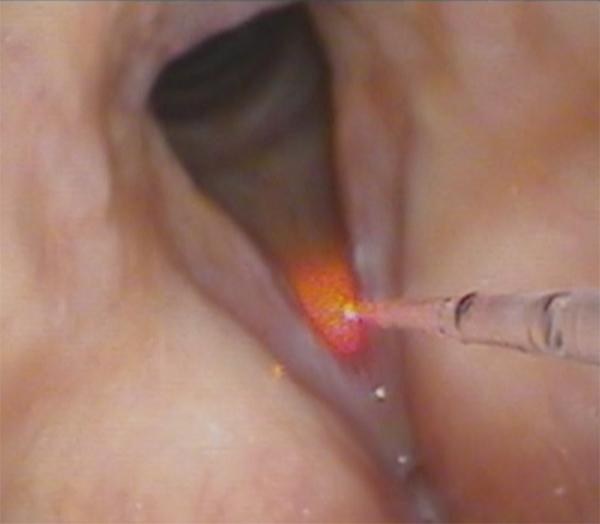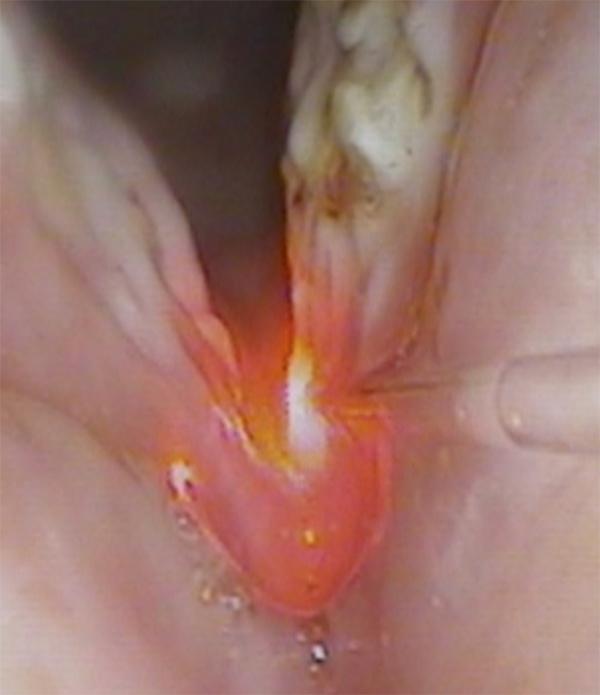What is in-office laser treatment?
In-office laser treatment is a technique used to treat selected vocal fold problems with a laser beam, in patients who have not been put under sedation. A topical or injected anesthetic numbs the throat and vocal folds without altering the patient’s level of consciousness - in contrast with general anesthesia, which causes various degrees of induced sleepiness and poses additional risks.
This treatment is is a relatively new technique, made possible by the development of lasers that can be used through flexible fibers, and performed by a laryngologist trained and credentialed in the use of medical-grade lasers. The procedure is conducted by threading a glass fiber, which will carry the laser beam used to treat the disease, into a flexible endoscope passed through the patient’s nose to reach the vocal folds. This allows excellent visualization of the target region by the operating laryngologist.

View of the laser fiber making its approach to the vocal folds - the red aiming beam is used to optimize the surgeon’s precision in targeting the areas to be treated.
What is in-office laser treatment used for?
In-office laser treatment is generally used to cure or control a variety of conditions affecting the vocal folds. Different mechanisms may be used to achieve this result.
In most cases, the laser beam is used to destroy or reduce the size of benign growths or abnormal tissue located on the vocal folds. Examples of conditions treated this way include papilloma, Reinke’s edema, and certain polyps. A similar application can be used in the treatment of premalignant conditions, such as selected leukoplakia or erythroplakia lesions. It is particularly useful in the management of certain recurrent disorders, making it unnecessary to return to the operating room for every treatment.
Another way of delivering this laser energy to attain a therapeutic benefit, is to use that energy to induce subtle changes in the microscopic structure of the vocal fold. In this application, the goal would be to remodel the abnormal layers of the mucosa rather than to destroy them. This is typically the rationale for the use of in-office laser treatment in the management of vocal fold scar, for instance.

The laser fiber makes precise contact with the area needing treatment. The lesion seen here, on the right side of the image, is a premalignant leukoplakia of the vocal fold.
What is the patient experience of in-office laser treatment?
Minimal preparation is required. There is no need to fast in anticipation of the procedure, and most home medications can be taken without interruption. Immediately before the procedure, local anesthesia is administered either by nebulization, direct application or injection to the nose, vocal folds and larynx. Special precautions are taken whenever a laser is used, including the use of protective eyewear by everyone present in the treatment suite, including the patient, physician and staff.
A flexible laryngoscope is inserted into the nose and brought into visual position to the lesion to be treated. The laser fiber passes through the laryngoscope, so there is no additional discomfort. During the procedure, the patient may be aware of a sensation of touch, pressure or heat at the area being treated, but there is no sharp pain. With proper preparation, the patient’s experience of the procedure is comparable to a simple flexible laryngoscopy examination through the nose, apart from the slightly longer duration (typically about one half hour for a laser procedure).
After the procedure, the patient is observed for some additional time before leaving the office. There is usually no major restriction in activity or diet once the anesthesia wears off, although voice rest is often helpful in facilitating recovery. The local anesthesia effects will dissipate within one to two hours, leaving the patient with a mildly sore throat. The voice quality may become strained or harsh from swelling of the vocal folds, but will return to baseline within a few days.
Office Laser Procedure: What can I expect?
What are the risks of in-office laser treatment?
The main risk of any laser treatment lies in the potential damage the laser energy can inflict on the normal tissue surrounding the lesion. This rarely happens directly as a result of inadvertent targeting, but more frequently occurs through indirect diffusion of laser energy into the neighboring tissue.
While swelling of the vocal folds is common after a laser procedure, with symptoms similar to those of laryngitis, it usually resolves rapidly without adverse consequences. More concerning is the risk of permanent scar formation on the vocal fold, which can cause a permanent alteration of its vibration properties, and some degree of hoarseness that may never recover.
It is therefore important that an in-office laser procedure be performed only in the proper situation, when the disease is amenable to this type of approach. Even when the disease is amenable, laser treatment may not offer superior results to a more traditional surgical procedure. The relative merits and risks of laryngeal disease treatment procedures are to be discussed with your laryngologist.

